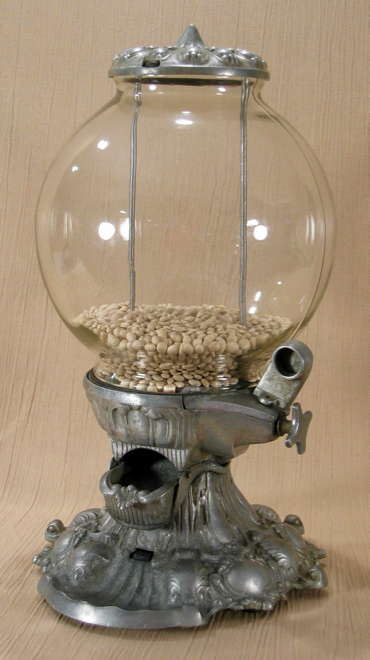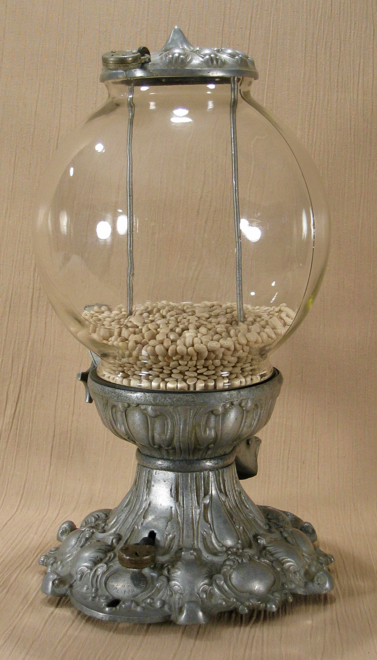___________________________________________________________________________________________
Simpson Simplex (a.k.a. Leebold)


___________________________________________________________________________________________


R. D. Simpson Co., Columbus, OH, c. 1917, 17". The Simplex is an ornately-cast aluminum machine that has to be one of the 360-degree-prettiest models ever made. I don't usually show the backside of a machine in the featured pictures above the description, but geez!---look at this thing! How could I not show it?
As far as describing the machine itself, there's not that much to say. It's designed to vend bulk product, not gumballs. You put a penny in the coin slot, turn the knob which is attached to an axle which is attached to the piece that cups the product and rotates when the knob is turned, which dumps it into the product chute, from the top of which it falls and collides into the back of the gate. It's pretty simple.
As far as I know, three or four variations exist that differ only in the labeling.
I'm guessing that the unlabeled generic version is the most common of these. Despite that, there may be something I don't quite understand about this example that makes it unusual. I bought this from a quite-knowledgable long-time collector who has a theory based on the "patent pending" embossment on the back of the machine, and how it related to the Simplex/Leebold history and assignment of versions. You can see the stamp here. He wrote an article about it in the published-thrice-yearly magazine of the Coin-Operated (sic) Collectors Association, and this is the machine that inspired that article. I remember not quite following all the details and I recall even fewer of them now---and don't have that issue handy so I can't check it for reference---but if I remember to check it next time I'm where the magazines are then I'll try to remember to update this page. That's a lot of remembering, but I'll try.
It took a long time for this model to grow on me, which surprises me when I look back on it. They're not common but they're not rare, and I've seen them throughout my years of collecting. In the 1990s I told people I'd never buy one because they didn't thrill me enough to justify the price. They were pretty and I could see the appeal, but they were expensive and the heft factor was too low for me. If it were cast iron I'd have been all over it---well, not then I wouldn't have, but sooner than I eventually was. It cost more than I was willing to spend on any machine in the 1990s, but it would have been on my I-can-dream list instead of being nowhere on my radar. I wasn't gonna spend that kind of change on a machine that's that light---I really did want heft to my machines back then. I still like a dense machine, but it's no longer a deal-killer if it doesn't have it. Annnywayyy, over the years my attraction to the Simplex grew slowly, and as I got older and my muscles atrophied from advancing age the machine seemed not as light as it used to be. Its perceived heft factor grew, and my minimum threshold for acceptable heft factor decreased, and eventually the two crossed and shazam!---it was on my list. At the same time I came to appreciate more and more just how damned gorgeous this model is, and wondered what took me so long to see that. It's now one of my most favorite machines, and I expect that the next time it's available for someone else to own will be when my wife or daughters are selling it from my estate, which (knock on wood) hopefully won't be soon.
The machine pictured above is 100% original and perfect in every respect. When I dream about the ideal patina on an aluminum machine, it looks just like this. When I moved to Boston in May of 2018 and rented a small apartment downtown, I took a minimalist approach and as part of that I resolved that I'd bring only one machine. When the time case to choose one I walked slowly along the shelves in my office and looked at each one and thought, "Is this the one?" I came to the Simplex early in that process and didn't need to go any further. This was the one, and it now sits on my dresser in Boston. I've since gone nuts and brought 2 more machines east, but this is the one that I most often pause to admire.
___________________________________________________________________________________________
___________________________________________________________________________________________
©Small Vintage Vending 2019